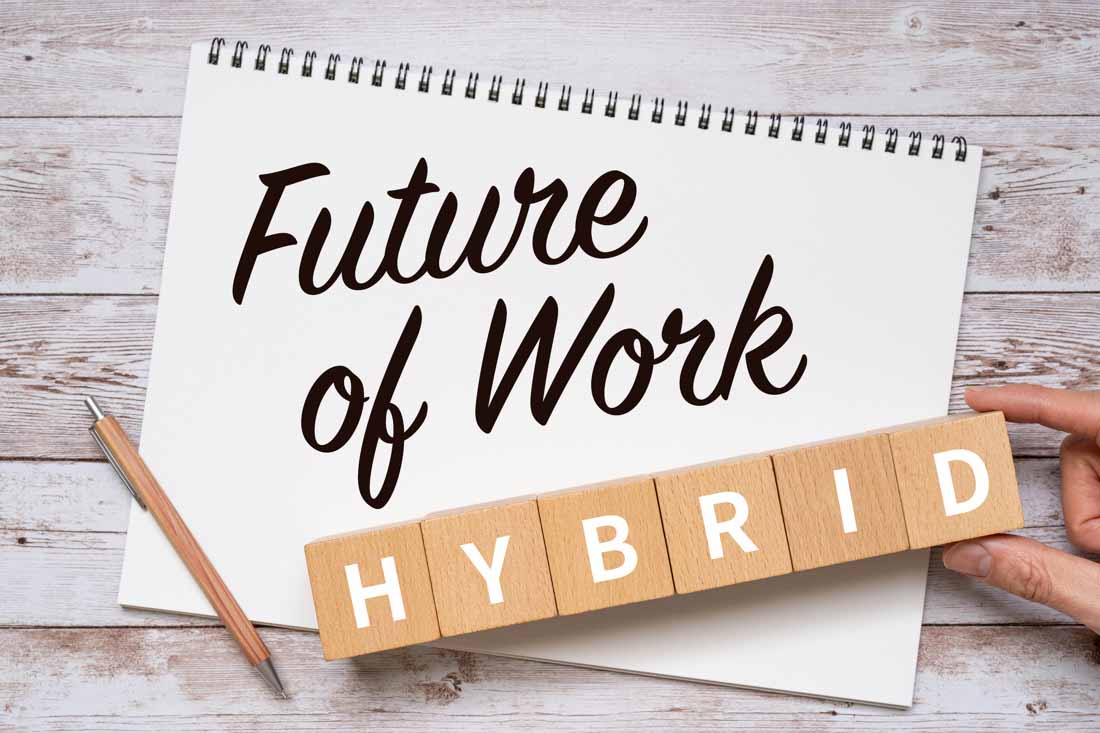These days, hybrid workforces come in all shapes and sizes. Even the Yahoos of the world that once banned working from home — gasp! — have long since reversed course. The hypothesis that daily in-person collaboration is essential to success hasn’t been borne out by research.
Still, hybrid work is in its infancy. And while we’re yet to see what shape it ultimately takes, there’s plenty to learn from the latest hybrid workforce trends.
What is a hybrid workforce?
A hybrid workforce blends remote work and in-office work, allowing employees to divide their time between working from home and collaborating in a traditional office environment. This model is common in industries such as technology and finance, where skilled employees can complete most or all of their work without face-to-face contact.
Most hybrid workforce models fall under one of three categories:
- Primarily in-office: Employees report to the office most days, with the flexibility to work from home as needed to help accommodate doctor's appointments, sick kids and other personal needs.
- Primarily remote: Team members work from home most days, with office space available on an as-needed basis.
- Split schedule: Employees split their time evenly between remote work and in-office work.
Some hybrid work teams have full autonomy to choose where and when they work. Others follow preset schedules. And in many hybrid environments, organizations encourage employees to follow guidelines or work with managers when determining which days to spend at the office.
Why the hybrid workforce is becoming more common
Hybrid work has become wildly popular in recent years — for good reason. This flexible work approach accounts for the diverse needs of different employees, making for a more adaptable, agile workplace. But that’s not all. Several key drivers are making hybrid work an increasingly attractive option for organizations of all sizes.
1. New technology
Fueled by the COVID-19 pandemic, when many organizations embraced remote work for the first time, hybrid work technology has exploded. In addition to team collaboration and project management tools, organizations now have easy access to all kinds of options. There are virtual desktops to keep data secure, digital workspaces to make tools readily available and even hybrid workforce management software to help managers understand where, when and how people are most productive.
2. Employee demand
More employees have experienced the benefits of remote work than ever before — and they want more of it. Nearly 40% say hybrid work is their ideal schedule, and another 32% prefer to be fully remote. In contrast, just 29% want to work at an office full time. In fact, more than a third of employees feel so strongly about hybrid work that they’d look for a new job if their current employers required them to return to the office full-time.
3. Real estate
For many organizations, the hybrid workforce is a cost savings opportunity. Commercial real estate vacancy topped 20% in 2023 for the first time in decades, and many companies plan to cut back even more. Hybrid work allows companies to scale down to smaller offices, which presents costs savings on real estate, taxes, and utilities.
Benefits of a hybrid workforce
Hybrid work offers numerous benefits for both companies and employees. Some of the biggest advantages are:
More work-life balance
One of the primary benefits of hybrid work is the flexibility it provides. It means less time commuting, more time to focus and plenty of opportunities to balance work life with personal needs. And according to research, this makes a big difference. One survey found hybrid and remote workers are far more satisfied with work-life balance then full-time office employees. Similarly, when Gallup compared the experiences of in-office, hybrid and remote employees — 76% named improved work-life balance as the top benefit.
Increased productivity
Contrary to common misconceptions, the hybrid work model increases productivity. It removes the need for arbitrary work hours and locations, freeing employees to create their own distraction-free environments where it’s easy to focus. It also allows hybrid teams to work when and where they’re most productive, whether that’s early morning in a quiet office or later in the day at home.
Higher engagement
When employees have the freedom to work from their desired locations, they tend to be more engaged and less burned out. In one of the largest hybrid work studies ever conducted, researchers found hybrid employees perform as well as — or better than — their in-office colleagues. They’re also more committed to their companies. Hybrid employees were less likely to quit and more likely to recommend their workplace to others.
Challenges of a hybrid workforce
While they don’t outweigh the benefits, the hybrid workforce does come with challenges. The most important ones to address are:
Communicating and collaborating
Ensuring consistent communication is more challenging for managers when different team members work from different locations — even more so if some employees are fully remote and others report to the office. The biggest risk is overlooking offsite employees who may feel left out, unseen or unheard.
Managing a remote workforce
In Microsoft’s Work Trend Index, 85% of leaders said they lack confidence in employees to be productive when working from home as part of a hybrid schedule. Managers accustomed to seeing employees on a daily basis often struggle with the lack of visibility that comes with work-from-home arrangements.
Increased security risks
Protecting company data is more challenging when employees work offsite. Home and public Wi-Fi are less secure than company networks, and personal devices open the door to malware and other threats.
Is the hybrid workforce actually the future of work?
Based on the latest research, this certainly seems to be where the workplace is headed — at least in industries that support remote work.
According to Gallup’s hybrid work indicators, six in 10 employees with remote-capable jobs prefer a hybrid arrangement. Approximately one-third prefer to be fully remote and less than 10% want to work on-site. In fact, 29% of hybrid employees (and 64% of full-time remote workers) are “extremely likely” to look for new jobs if their current employers stop offering flexible work options.
That said, most hybrid organizations plan to stay hybrid. In a 1,000-person survey conducted by Resume Builder, most business leaders either require employees to come to the office or plan to do so soon. However, those policies don’t apply to everyone. And less than one-fifth will require people to come in five days a week.
And if return to office mandates have taught us anything, it’s that providing more work options — not less — offers undeniable benefits. Nine in ten employees say working from home has positively impacted physical health, while 40% report less stress and burnout. For this reason, many organizations are exploring happy mediums by asking people to come to the office just two or three days a week.
Best practices for shifting to a hybrid workforce
While most organizations are still figuring out hybrid work, several best practices have emerged as clear winners for effective hybrid workforce management.
- Collaborate on scheduling: Teams that set their hybrid policies together have the highest levels of engagement, yet just 12% of organizations currently take this approach. Don’t create schedules in a vacuum — collaborate with employees to determine what works best.
- Establish clear guidelines: If you don’t have an official policy in place — or if you do but not everyone follows it — create one. Not sure where to start? Download ActivTrak’s hybrid work policy template for an easy-to-customize framework.
- Invest in the right technology: Providing the right hybrid workforce technology is a must. Your employees need tools that adapt to different work environments, such as a laptop that travels well and software that’s easy to access from anywhere.
- Embrace trust and transparency: It’s not just where employees work but how you manage them that matters. Research indicates having an effective manager is four times more important for engagement and well-being than work locations. Focus on setting clear expectations, providing support and offering regular feedback.
- Focus on fostering a strong culture: Studies show employees who have consistently positive workplace experiences drive more innovation and make their companies more profitable, regardless of where they work.
- Use workforce analytics to guide decisions: Don’t just guess at what makes for an effective hybrid workforce. Use data to guide you. With a platform like ActivTrak, you can get all kinds of real-time insights on where people work — and where they work best.
- Invite employees to self monitor: Consider providing personal insights dashboards to help people see when and where they're most productive so they can build healthy hybrid work habits.
Future-proof your hybrid workforce with ActivTrak
Hybrid work opens the door to numerous advantages, from improved morale to higher retention. The sooner you identify the ideal hybrid schedule for your unique workforce, the faster you’ll experience these and other benefits. But making those decisions typically takes time and involves a lot of trial-and-error.
ActivTrak’s hybrid workforce management platform removes the guesswork, making it easy to make decisions in minutes — not weeks or months. More than 9,500 organizations use it to:
- Compare remote and onsite productivity
- See how workplace policy affects the workforce
- Uncover offsite compliance issues
- Identify and resolve inefficient workflows
Get a free demo to learn effective strategies for creating a highly productive hybrid workforce starting today.





